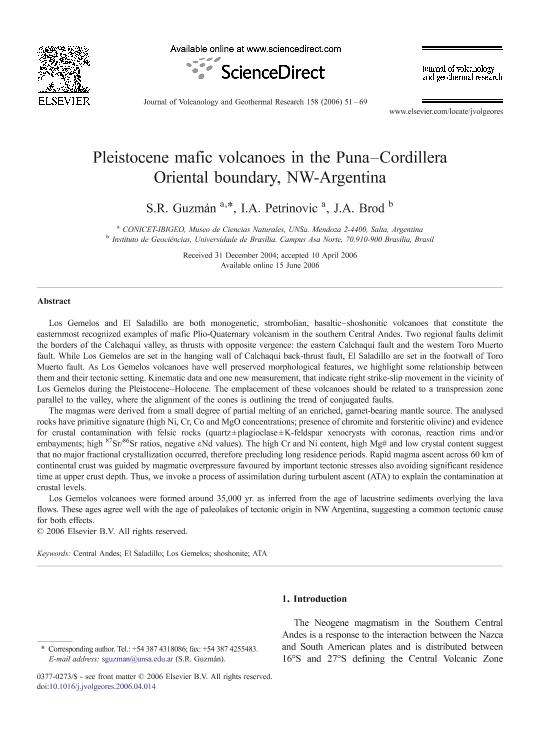Artículo
Pleistocene mafic volcanoes in the Puna-Cordillera Oriental boundary, NW-Argentina
Fecha de publicación:
11/2006
Editorial:
Elsevier Science
Revista:
Journal of Volcanology and Geothermal Research
ISSN:
0377-0273
Idioma:
Inglés
Tipo de recurso:
Artículo publicado
Clasificación temática:
Resumen
Los Gemelos and El Saladillo are both monogenetic, strombolian, basaltic-shoshonitic volcanoes that constitute the easternmost recognized examples of mafic Plio-Quaternary volcanism in the southern Central Andes. Two regional faults delimit the borders of the Calchaquí valley, as thrusts with opposite vergence: the eastern Calchaquí fault and the western Toro Muerto fault. While Los Gemelos are set in the hanging wall of Calchaquí back-thrust fault, El Saladillo are set in the footwall of Toro Muerto fault. As Los Gemelos volcanoes have well preserved morphological features, we highlight some relationship between them and their tectonic setting. Kinematic data and one new measurement, that indicate right strike-slip movement in the vicinity of Los Gemelos during the Pleistocene-Holocene. The emplacement of these volcanoes should be related to a transpression zone parallel to the valley, where the alignment of the cones is outlining the trend of conjugated faults. The magmas were derived from a small degree of partial melting of an enriched, garnet-bearing mantle source. The analysed rocks have primitive signature (high Ni, Cr, Co and MgO concentrations; presence of chromite and forsteritic olivine) and evidence for crustal contamination with felsic rocks (quartz ± plagioclase ± K-feldspar xenocrysts with coronas, reaction rims and/or embayments; high 87Sr/86Sr ratios, negative εNd values). The high Cr and Ni content, high Mg# and low crystal content suggest that no major fractional crystallization occurred, therefore precluding long residence periods. Rapid magma ascent across 60 km of continental crust was guided by magmatic overpressure favoured by important tectonic stresses also avoiding significant residence time at upper crust depth. Thus, we invoke a process of assimilation during turbulent ascent (ATA) to explain the contamination at crustal levels. Los Gemelos volcanoes were formed around 35,000 yr. as inferred from the age of lacustrine sediments overlying the lava flows. These ages agree well with the age of paleolakes of tectonic origin in NW Argentina, suggesting a common tectonic cause for both effects.
Palabras clave:
Ata
,
Central Andes
,
El Saladillo
,
Los Gemelos
,
Shoshonite
Archivos asociados
Licencia
Identificadores
Colecciones
Articulos(IBIGEO)
Articulos de INST.DE BIO Y GEOCIENCIAS DEL NOA
Articulos de INST.DE BIO Y GEOCIENCIAS DEL NOA
Citación
Guzman, Silvina Raquel; Petrinovic, Ivan Alejandro; Brod, José Affonso; Pleistocene mafic volcanoes in the Puna-Cordillera Oriental boundary, NW-Argentina; Elsevier Science; Journal of Volcanology and Geothermal Research; 158; 1-2; 11-2006; 51-69
Compartir
Altmétricas




